Impacts
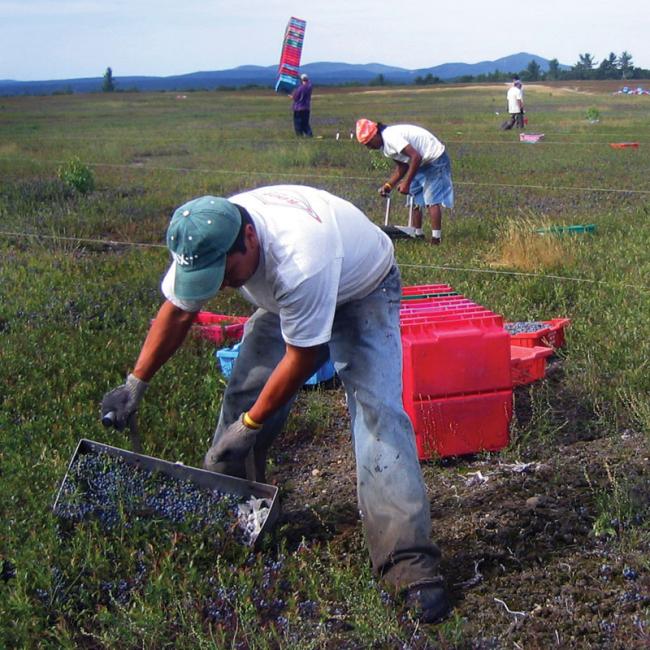
Blueberry Worker Ergonomics
Farmworker Safety and Health
The Challenge:
Each year, approximately 8,000 migrant and seasonal farmworkers participate in the manual harvesting of blueberries in Maine. Manual raking of blueberries can lead to musculoskeletal pain and injury. Musculoskeletal strains are among the most common injuries for migrant and seasonal farmworkers. Farmworkers have traditionally used a rake with a single, short handle. Raking requires consistent bending at the waist and rapid, repeated, forceful motions.
Impact:
Northeast Center (NEC) researchers used a community-based approach to develop a new blueberry rake. A long, 2-handled blueberry rake design was tested and proven to increase productivity, require less force and reduce pain amongst farmworkers. A two-year follow up showed over 70% of those interviewed now use a long handled rake.
Approach:
Employing a community-based approach to public health intervention targets a community which can help provide resources and serve as an agent of change. The community-based approach used in this project created the ability to access the experience of knowledgeable individuals in the selection of potentially effective alternatives to the traditional blueberry rake. This project included both migrant farmworkers and employers which enhanced access to workers, access to work sites and the process of planning the trials.
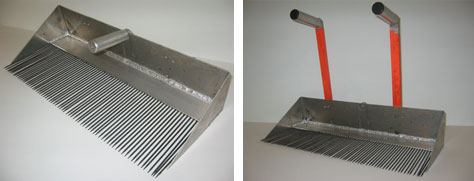 Short- and long-handled blueberry rakes
Short- and long-handled blueberry rakes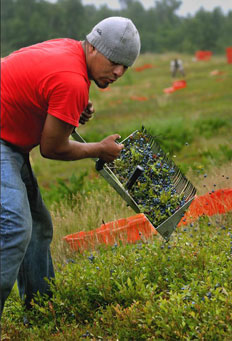 Photo by Earl Dotter
Photo by Earl DotterResults:
After a pilot study employing 12 rake designs, the project focused on a comparison between the extended handle modification and the traditional, short handle blueberry rakes. There was increased productivity, greater acceptability, less force used and less pain reported with the extended handle design. The extended handle rake may prove effective in reducing musculoskeletal injury associated with blueberry harvesting. A community-based approach to migrant farmworker injuries can be effective, particularly if employers participate.
Additional Resources:
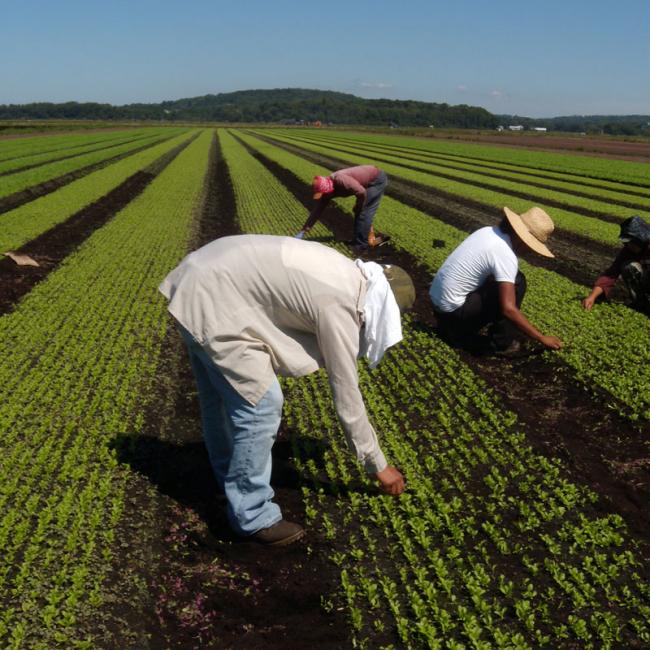
Culturally Appropriate Farmworker Safety Materials
Occupational Injury Reduction
The Challenge:
Language and educational barriers present unique challenges for farmworker health and safety. Of the estimated three to five million migrant and seasonal farmworkers in the U.S., more than three-quarters (77%) are foreign-born. Farmworkers perform much of the manual labor on farms today, and thus they are at high risk for muscle strain as well as traumatic injury. Language and cultural barriers, along with little formal education, often prevent farmworkers from understanding safety warnings and other information intended to protect them.
Impact:
The Northeast Center has created culturally appropriate, multilingual safety materials with input from the migrant and seasonal farmworkers who will use them. To date, researchers have developed safety posters and other print materials on 23 different topics, and pilot-tested them with farmworkers for clarity and impact. Thousands of copies of these materials have been distributed to the agricultural community throughout the Northeast.
Approach:
Northeast Center (NEC) researchers have collaborated with migrant and seasonal farmworkers to communicate the results of farmworker research, and to present safety warnings and recommendations in a way that is meaningful to farmworkers. Posters and other materials are pilot-tested with focus groups, using a strategy of: discussing the topic in general, capturing experiences, views and feelings of participants around the topic, and then presenting multiple versions of material for discussion and critique. In this process, farmworkers have expressed over and over again the importance of presenting imagery of real farmworkers in actual situations.
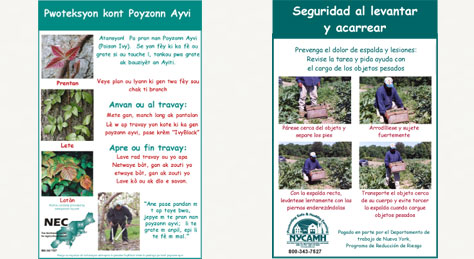
Sample print materials
Results:
This participatory materials development approach has resulted in:
- Printed safety posters and flyers on 23 topics (in 2 or sometimes 3 languages), as well as English-language brochures, are available free for download at www.nycamh.org. To date, we receive thousands of requests or downloads of these print materials each year.
- The process of material co-creation has been integrated into NYCAMH and Northeast Center community-based participatory interventions, such as in New York's Hudson Valley region. Farmworkers worked with researchers to develop pocket guides on eye safety to accompany a protective eyewear and eye wash promotion project. Close to 1,000 copies of the materials have been distributed to date.
- Similarly, farmworkers in a Connecticut shade tobacco region collaborated with researchers to develop teaching materials for bilingual trainings on pesticide safety, hand washing, clothing storage, and laundry techniques. To date, close to 1,000 workers have been trained using these materials.
- Northeast Center researchers also employed this technique to develop materials to effectively communicate results from the National Agricultural Workers Survey to migrant and seasonal farmworkers.
Additional Resources:
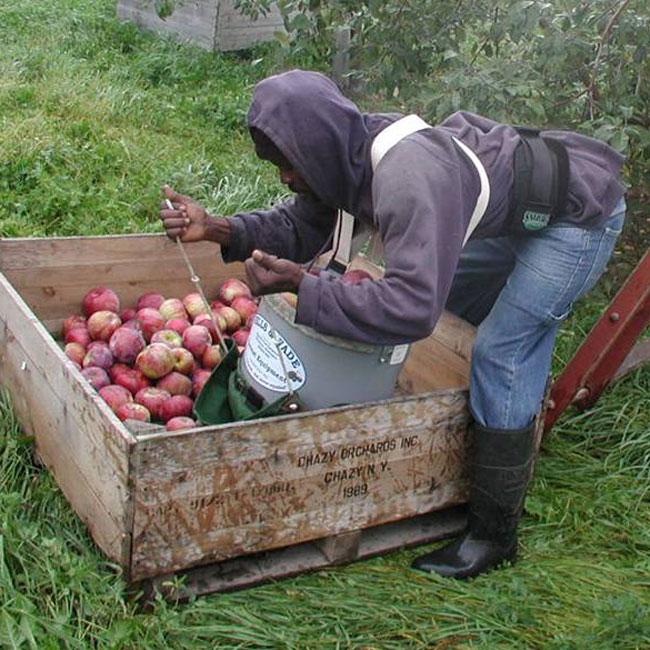
Orchard Ergonomics
The Challenge:
Orchard work is associated with musculoskeletal injury, largely as a result of carrying loaded apple buckets for hours. During much of that time, workers are also twisting and stooping. Musculoskeletal strain, especially in the back, neck and shoulders, is one of the most common injuries among migrant and seasonal farmworkers.
Impact:
NEC researchers designed an ergonomic hip belt designed to reduce pain and strain among orchard workers. The belt redistributes weight from the upper back, neck and shoulders to the hips. It has been shown in laboratory and orchard testing to significantly reduce the load on several key muscles. Currently researchers are field testing different belt options to arrive at one universally preferred model.
Approach:
Researchers held informal meetings with orchard owners and managers, farm workers, and other apple industry representatives to discuss a range of possible intervention ideas. The aim of this project was to reduce injuries due to sprains and strains and to improve picking comfort, without compromising harvesting efficiency.
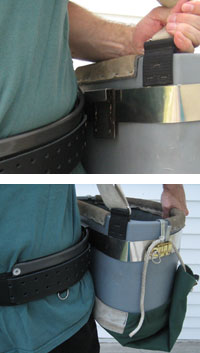
Close-up of current belt design
Results:
Ideas were evaluated on potential cost, acceptability to workers, and impact on harvest speed. The intervention that emerged from this process was a hip belt that attaches to the apple picking bucket (see photos). The ergonomic belt redistributes weigh from the upper back, neck and shoulders to the hips and does not appreciably slow picking speed. In laboratory studies, significant reductions in muscle activity were seen with belt use.
A new design has been developed using suggestions from workers who tested the equipment. Tools are no longer needed to install the hook on the bucket, and the system incorporates "off the shelf" components to lower production costs. The new belt design is currently being tested in several orchards around the Northeast.
Additional Resources:
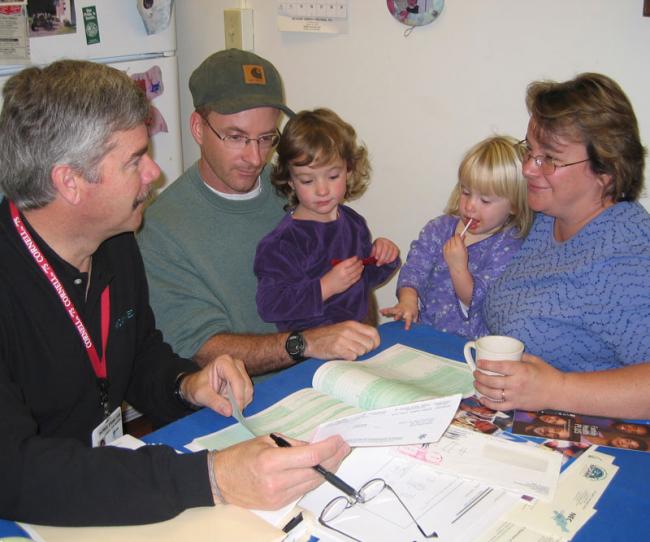
Farm Partners
Stress and Mental Health
The Challenge:
According to the National Institute for Occupational Safety and Health (NIOSH), farming is one of the top ten most stressful occupations. This stress can be significantly increased as a result of the depressed economy, decreased farm milk price, lack of health care coverage, aging farm population and farming with a disability. It can be difficult knowing where to turn for assistance and what services are available.
Impact:
The NYCAMH Farm Partners Program was established in 1992 to address the problems associated with work-related stress in farming. Farm Partners provides free and confidential on-farm counseling and case management assistance to farmers and their families. The Farm Partners Program utilizes the "team approach" and works in conjunction with other farm human service agencies to assist the farmer with problem solving. The most common issues for which farmers sought help were: a lack of medical insurance (27%); physical disability (27%); and mental health concerns (15%).
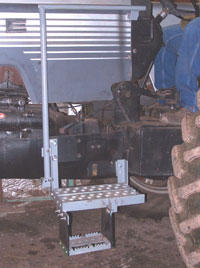 Tractor step modifications allowed a disabled farmer to continue farming
Tractor step modifications allowed a disabled farmer to continue farmingApproach:
A licensed social worker goes to the farm and assists the farmer with the completion of all required paperwork, enabling them to apply for Medicaid, Family Health Plus, hospital financial assistance or Social Security Disability. The social worker then applies for services, as a representative of the farmer, allowing the farmer to remain on the farm. The social worker assists disabled farmers in securing the services they need to remain farming. If the farmer is unable to continue farming due to disability, the social worker assists the farmer in applying for Social Security Disability.
Results:
- Farm Partners staff have successfully applied for Medicaid, Family Health Plus and hospital financial assistance for numerous farm families.
- Successfully appealed a hospital denial of $89,981 in financial assistance.
- Farm Partners staff have secured over $500,000 in hospital financial assistance.
- Successfully appealed insurance company denials, $24,000 in Workers' Compensation back payments and $30,000 in Social Security overpayments.
- Collaborated with VESID and agricultural engineers to provide over $10,000 in vehicle, tractor and equipment modifications for disabled farmers.
- Secured three 4-WD farm utility vehicles for disabled farmers.
- Successfully applied for Social Security Disability for 15 disabled farmers.
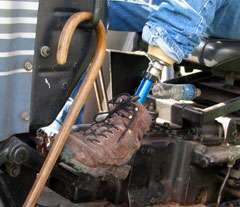
Additional Resources:
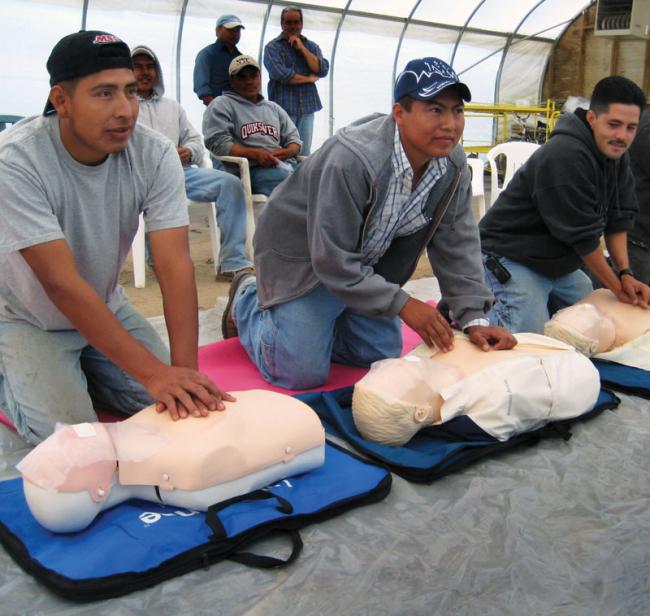
Farm Emergency Response Program
Occupational Injury Reduction
The Challenge:
In an emergency, there are many challenges associated with farm rescues. In rural areas it may take over 30 minutes for EMS to arrive on-scene, especially to remote locations such as fields. Rescuers may not be familiar with farm hazards such as large animals, chemicals, or machinery. Many farmers and their families are not trained in first aid and rescue and may not know what to do in a fire, tractor rollover, machinery entanglement or other farm emergency. They may even endanger themselves trying to save a loved one.
Impact:
The Farm Emergency Response Program (FERP) provides free on-farm training in English and Spanish to New York farmers, farmworkers and farm family members. The training provides the skills needed to safely respond to an emergency situation on the farm without putting oneself in danger. In its first two years, the program has reached over 2,000 individuals who might not otherwise be prepared for an emergency.
Approach:
In 2008, NYCAMH received grant funding from the New York State Department of Health to develop the FERP program. NYCAMH safety educators received instructor training in order to provide CPR and first aid certification to farm families and workers through the American Heart Association. They also purchased equipment and developed materials for conducting emergency response trainings on the farm. Training topics were offered in English as well as Spanish.
FERP Training topics offered:
- First response to farm emergencies
- Basic first aid
- Fire safety and extinguisher use
- First aid and CPR certification
One important aspect is that training is held on the farm, in the environment where a farm emergency would occur. FERP training includes discussion of rescuer safety: emergency preparedness, staying calm, calling for help, and assessing the scene before attempting to help the victim.
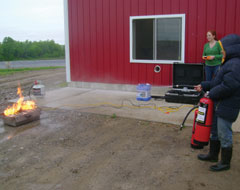 Fire extinguisher training
Fire extinguisher training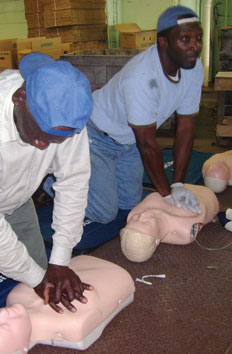 Farmworkers learning CPR
Farmworkers learning CPRResults:
The FERP program has provided farm emergency response training to over a thousand people since its creation in 2008. Feedback for this program has been overwhelmingly positive. One worker commented, "Thank you so much for this class, it's important and it helps." 100% of trainees have indicated that they felt they could apply the skills learned in an emergency.
Additional Resources:
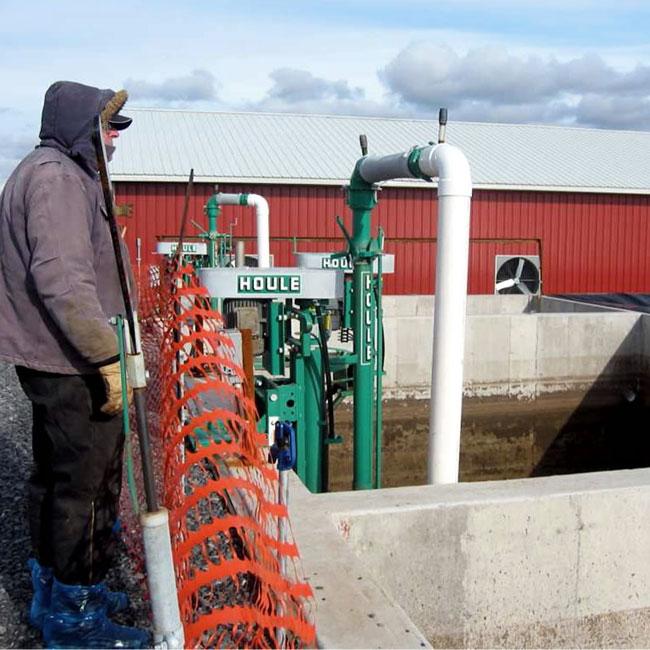
Proper Ventilation of Confined Space Manure Storage Facilities
Occupational Injury Reduction
The Challenge:
Fatalities due to entry into on-farm confined space manure storage facilities occur each year due to the oxygen-deficient atmosphere as well as toxic and/or explosive gases present. Most deaths occur to persons conducting repair or maintenance on equipment, or to those attempting to rescue another person in the storage facility.
Impact:
Northeast Center (NEC) researchers introduced a new International Engineering Standard (ANSI/ASABE S607), "Ventilating Manure Storages to Reduce Entry Risks" which has now been accepted. The standard provides ventilation rates, configurations, and air exchange rates required to reduce entry risk for 80-85% of manure storages. If the standard is adopted into new and existing storages, they will have a ventilation system capable of evacuating gases and replenishing oxygen to levels safe for human occupancy from five to greater than 15 minutes.
Approach:
Forced ventilation has been shown to be an effective way to lower the concentrations of noxious gases to levels safe for human entry into storage facilities. Experimental tests were conducted on rectangular and circular-shaped confined space manure tanks with solid, fully slotted and partially slotted covers.
Results:
Tests identified the most efficient evacuation of gases from the tank by optimal placement of the ventilation fan based on type of cover. The higher the air exchange rate, the higher the evacuation of potentially deadly gases from the confined space.
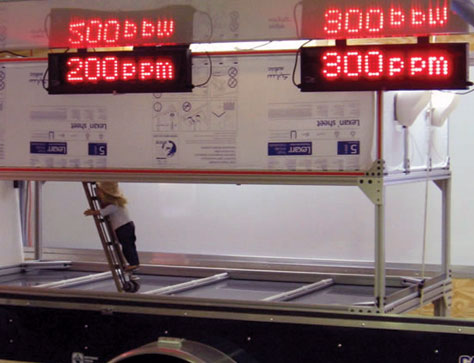
Close-up of confined space manure storage educational demonstration
Researchers developed the new International Engineering Standard (ANSI/ASABE S607), "Ventilating Manure Storages to Reduce Entry Risks" to specify the forced ventilation requirements, including ventilation system layout, air exchange rates, and minimum ventilation times for evacuation of contaminant gases from and replenishment of oxygen into on-farm confined space manure pits prior to entering. A simulator was also developed in order to educate confined space users about hazards, ventilation and measurement of gas concentrations.
Additional Resources:
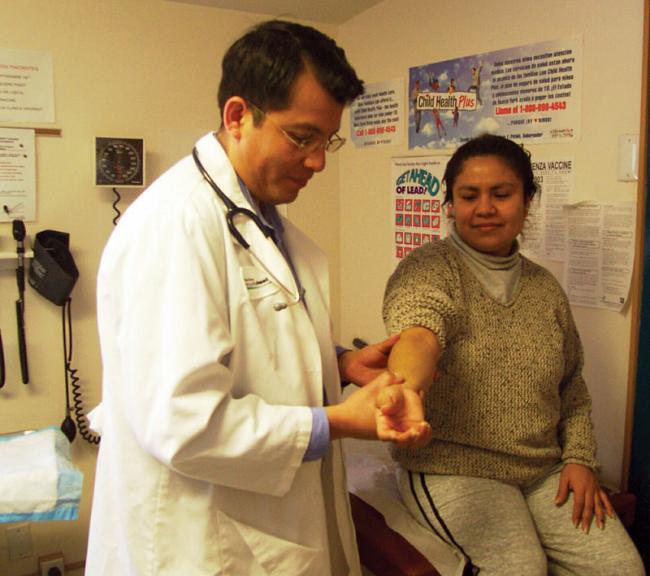
Migrant Clinician Occupational Health Reference Manual
Farmworker Safety and Health
The Challenge:
Occupational injuries and illnesses account for roughly 15% of adult farmworker medical visits at migrant health centers. However, a majority of the physicians and other medical care providers report that they do not have training in occupational medicine, especially as it relates to farm work. Additionally, a number of constraints make worksite assessments, which are a key component of occupational medicine, impossible in this setting.
Impact:
In response to a critical care issue that had been identified by clinicians themselves, researchers at the Northeast Center (NEC) developed a manual aimed specifically at meeting the occupational medical care needs of migrant and seasonal farmworkers. The manual was designed to assemble training and informational support in occupational medicine for migrant health center clinicians.
Approach:
To develop the manual, researchers first conducted extensive interviews with migrant health center clinicians. Their input has led to the design of the manual, a tabbed book with individual sections on: a) how to provide an occupational health history; b) "virtual" agricultural worksite visits (describing the field, orchard and livestock work environment); c) common work-related health problems among Northeast farmworkers; d) corresponding patient educational materials (in multiple languages); e) guidance on Worker's Compensation, and f) how to provide culturally competent care. This resource is also available online, with freely downloadable patient education materials. The manual was disseminated with assistance of the Migrant Clinician's Network, who promoted to member clinicians.
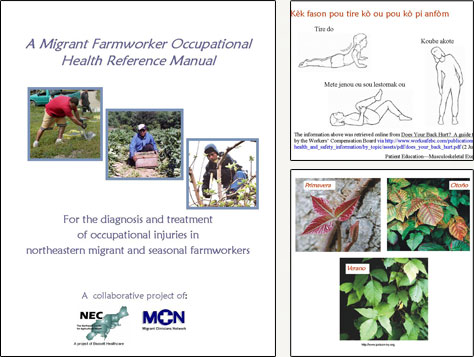
Sample pages from the manual
Results:
The manual has been widely distributed and is available both online and in print. In the first 3 months after establishing the manual link on the Migrant Clinicians Network website, the site received over 2,000 hits, predominantly on the patient education pages. Today, even with somewhat limited promotion, individual page hits range between 900 and 1,200 per quarter. In the coming year a new expanded edition will be published, featuring common farmworker health issues from other regions of the US.
Additional Resources:
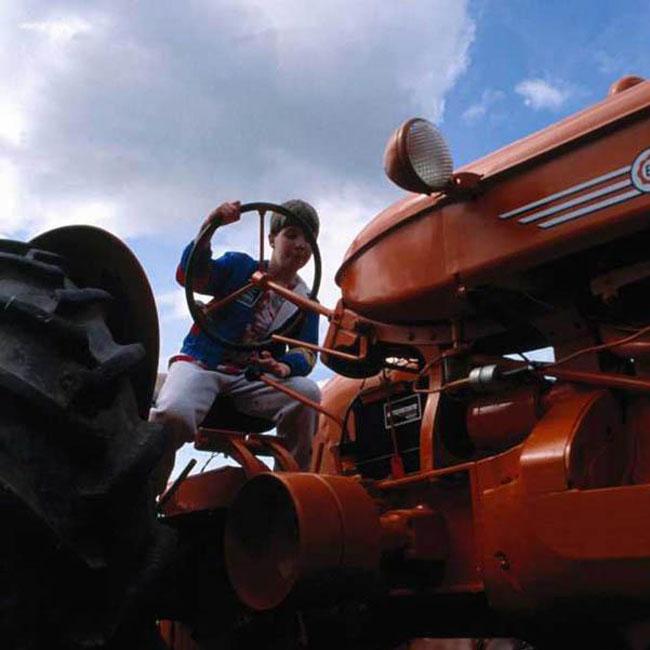
NAGCAT Promotion Intervention
Child Farm Injury
The Challenge:
Children who work on family farms have high rates of injury, as much as six times that of non-farm children. Many injuries occur when children attempt farm tasks which are not age-appropriate. Guidance for parents on safe farm task assignment according to child development science has not been effectively disseminated to Northeastern farm families.
Impact:
18 months after the Northeast Center (NEC) undertook a dissemination and evaluation program using the National Children's Center's new North American Guidelines for Children's Agricultural Tasks (NAGCAT), significantly more families in the guideline-based program set limits on the amount of time a child could work, provided more supervision to working children, and made other safety-related changes.
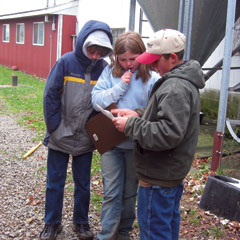 NAGCAT guidelines help farm families determine age-appropriate tasks for children
NAGCAT guidelines help farm families determine age-appropriate tasks for childrenApproach:
The North American Guidelines for Children's Agricultural Tasks (NAGCAT) is a resource developed to assist parents in assigning farm jobs to their children 7 to 16 years of age. NAGCAT recommendations for children's agricultural chores are not based on age. Instead, they focus on growth and development to assess a child's ability to complete a task and their need for supervision.
In this guideline promotion intervention, lay educators from the Northeast Center (NEC) visited selected farms to review NAGCAT guidelines with farm family members. To evaluate the effect of active NAGCAT promotion, data on childhood injuries, tasks, and hours worked were obtained quarterly for 21 months. Injury rates per farm were compared between the treatment and control groups, along with time span to occurrence of an injury and to violation of NAGCAT age guidelines.
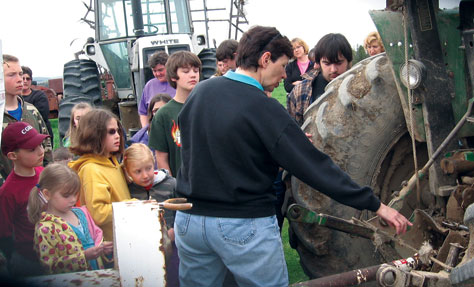
Results:
Intervention farms were less likely than control farms to violate NAGCAT age guidelines in the areas of all-terrain-vehicle use and tractor and haying operations. Participating farm families were more likely to follow age guidelines on using ATVs and tractors, hitching trailed implements to tractors, and baling hay.
Additional Resources:
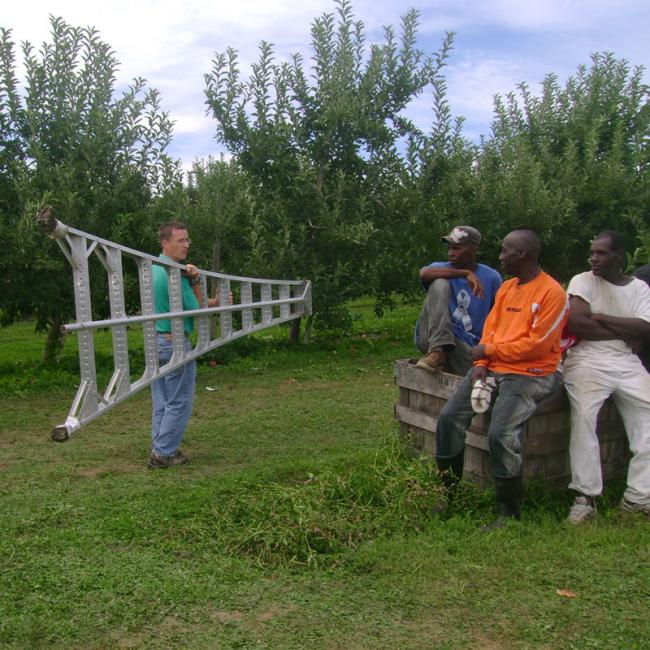
On-Farm Safety Program
Occupational Injury Reduction
The Challenge:
Farming is a hazardous industry, with high rates of serious and often fatal injury. The agricultural workforce is diverse in terms of age, experience, training and national origin. The challenge is to provide worksite safety training appropriate to the needs of farmworkers, many of whom have limited English skills.
Impact:
The New York Center for Agricultural Medicine & Health (NYCAMH) developed the On-Farm Safety Program to deliver safety education directly to farm owners and workers at their worksites, in English or Spanish. Post-training evaluations have consistently shown increased hazard awareness. In addition, farm owners who participate in the program regularly welcome trainers back year after year. This creates a positive safety environment with farm owners and workers alike. Approximately 70 farms request safety surveys annually, and trainings reach an average of 1,703 farm workers per year.
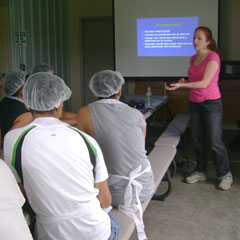 Packing house safety training
Packing house safety trainingApproach:
NYCAMH received grant funding from the New York State Department of Labor Hazard Abatement Board to provide on-farm safety trainings and on-farm safety surveys. Trainings and surveys were conducted at a time most convenient for the farm, at no cost, and were available to any size or type of farm in New York. All safety topics were offered in English and Spanish.
The on-farm safety training sessions were designed to increase the workers' knowledge of safe work practices and to positively influence safe work behaviors. A variety of topics were offered./p>
On-farm safety surveys aimed to identify potential farm hazards, make suggestions for improvements, and encourage farm owners to follow through on safety recommendations.
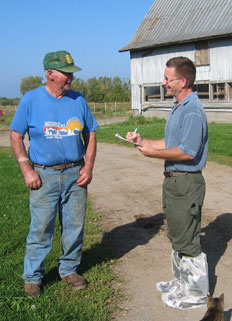 On-farm safety survey
On-farm safety surveyResults:
On average, 187 on-farm trainings are held, reaching 1,703 farmworkers annually. Post-training evaluations were collected from on-farm training session participants. Percentage reporting learning something new from the training:
- English speaking: 97.6%
- Spanish speaking: 87.5%
In a telephone follow-up survey, 95.5% reported observing workers using safe work practices as a result of the training session. Of those interviewed after conducting an on-farm safety survey, 82% reported having made improvements, and 100% are in favor of NYCAMH continuing to offer this program.
Additional Resources:
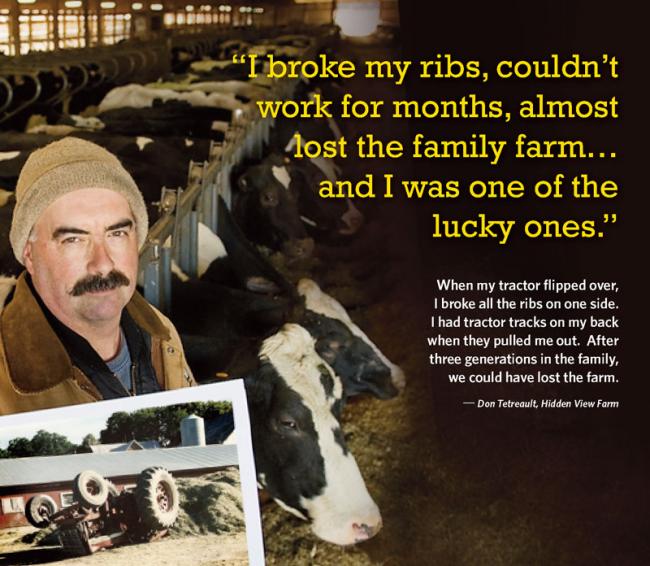
Preventing Tractor Overturn Injuries
Multistate ROPS Retrofit Program
The Challenge:
Tractor overturns are the most frequent cause of death on U.S. farms and are of particular concern in the Northeast region, which has the highest rate of overturn fatalities in the country. Installing rollover protective structures (ROPS) on all unprotected tractors is the only proven method for eliminating the deaths and injuries associated with these events.
Impact:
The Northeast Center used a social marketing approach, along with a retrofit hotline and rebate, to encourage farmers in New York to install ROPS on their tractors. The program has increased the sale of ROPS in New York ten-fold. The goal of the multi-state expansion project has been to assess whether a similar intervention model could be used to stimulate ROPS installation activity in Vermont, Pennsylvania, and New Hampshire.
Approach:
Social marketing requires: 1) selecting a target population; 2) identifying the population's motivators and barriers to change; and 3) developing solutions that make change easier. Formative research conducted in each of the participating states indicates that the most powerful disincentive among farmers to installing ROPS is cost, followed by the difficulty in finding and pricing ROPS, and misconceptions regarding personal risk. The intervention in each state has been designed to address these issues and each intervention component has been evaluated by the target population.
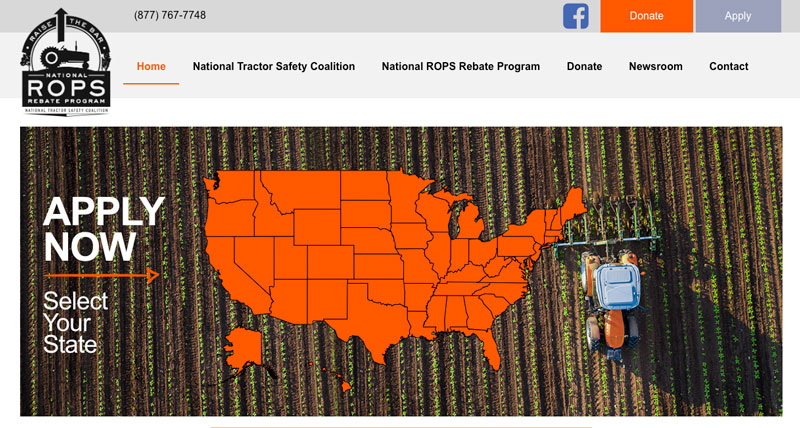
ROPS Retrofit Program website homepage
Results:
Each of the state programs have just been launched. The Vermont rebate program was launched on September 28th, 2010. In just five weeks, twenty Vermont farmers have already purchased ROPS for their tractors. New Hampshire's program was launched on November 30th, 2010, and Pennsylvania's program was launched on January 4th, 2011.

